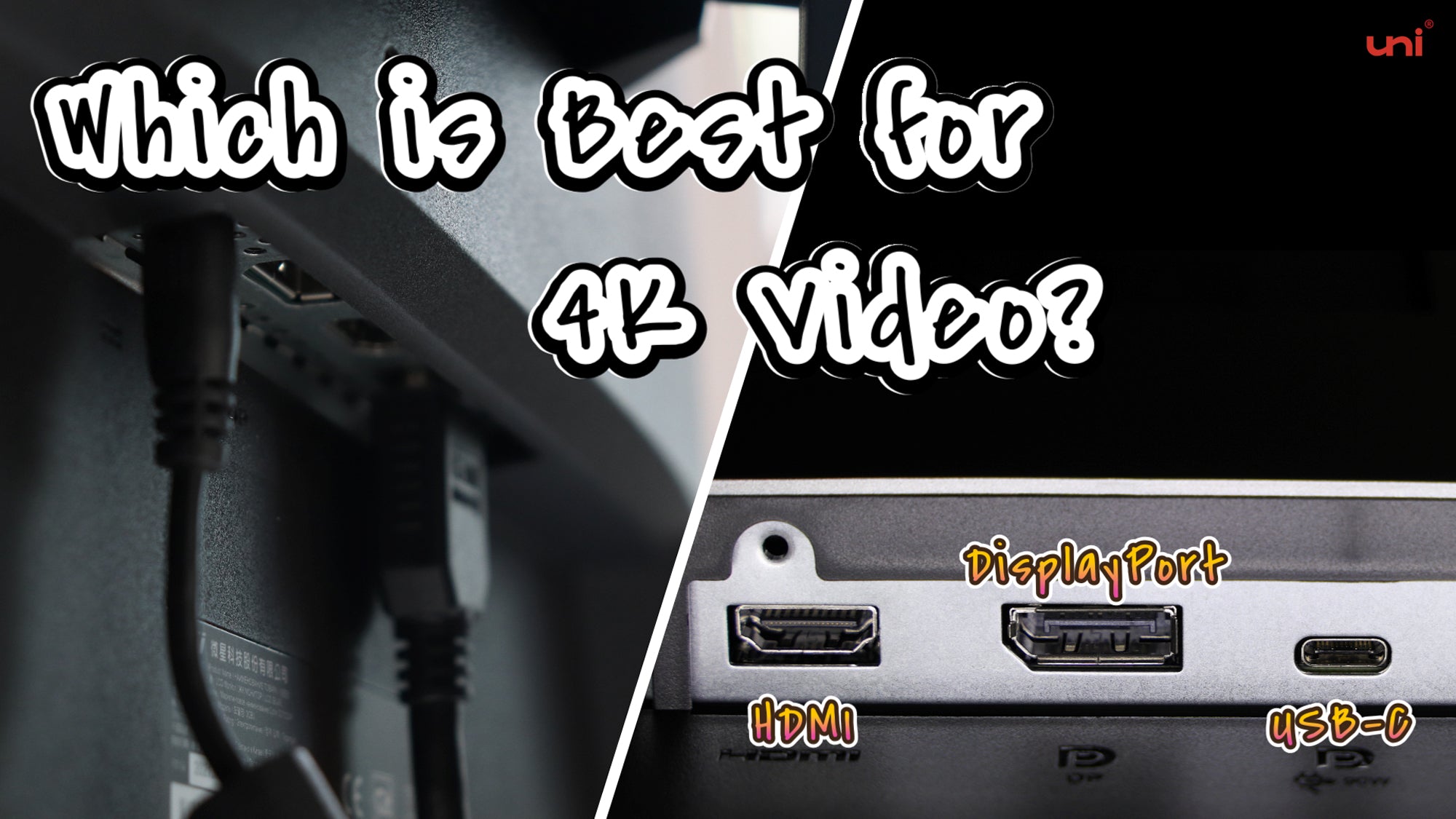How to Choose Between DP to DP Cable and HDMI to HDMI Cable?
February 14, 2023 7 min read
What are you plan for buying this cable?
It's much quicker option when you know exactly where you're going to use this cable.
· You wanna upgrading your gaming setup?
· You wanna pick a cable for your new monitor which has both DP and HDMI port?
· You want to get rid of the flickering issues when your screen running at 144Hz?
· You want to extending your third monitor using single connection?
· Or you needed a cheaper, but also nice-ish DP cable for a standing desk?
Some people think a cable is a cable but that is not entirely true.
Let me walk you through it.

Physical Connectors
The major difference between DisplayPort (DP) and HDMI cables is in their physical connector design and the type of devices they are meant to connect.
DisplayPort has a smaller and more compact connector with 20 pins, while HDMI has a larger connector with 19 pins. DisplayPort has a rectangular shape with a trapezoidal slot at the top of the connector with an asymmetrical shape, while HDMI has a more rounded rectangular shape with several curved sides, that’s symmetrical.
Different Capabilities & Purposes
DisplayPort is designed for use in computer and professional applications, while HDMI is widely used for consumer electronics and is suitable for a range of devices including TVs, Blu-ray players, and gaming consoles. DisplayPort cables are typically capable of supporting higher resolutions and refresh rates, while HDMI cables provide additional audio and video features such as multichannel audio and 3D video.
Next, check out your monitor which you meant to connect.
Gaming
Take ASUS TUF Gaming VG249Q monitors for example - This monitor is popular for its fast refresh rate of 144Hz, 1ms response time, and Full HD resolution, including DisplayPort 1.2 x 1, HDMI (v1.4) x 1.
Since the HDMI and DP both work at 144Hz@1080p on this monitor, you can choose both DP and HDMI cable. However, if you have an Nvidia GPU you'll need to use DP though in order to use Adaptive-Sync.
Plus, you must make sure you are using the DP 1.2 cable or above version, and HDMI 1.4 cable or above version.
-
Some of the popular gaming monitors that frequently use DP cables include the ASUS ROG Swift, Acer Predator X27, and the Dell Alienware 34. In addition, many professional-grade monitors such as the Dell UltraSharp U2719DX, the ASUS ProArt PA27AC, and the LG 27UK650-W also use DP cables.
It is important to note that the use of DP cables may vary depending on the specific needs and preferences of each user, and some users may prefer HDMI for its wider compatibility with consumer electronics devices. However, for high-performance gaming and professional applications, DP is often the preferred choice.
-
Special Features of DisplayPort
However, if you would like to use Multi-Stream Transport, which also known as MST, is a feature of DisplayPort (DP) cables that allows multiple displays to be connected to a single DP output and display different content on each screen, effectively acting as multiple independent displays. MST provides an efficient way to expand the desktop area for more productivity or to create a multi-monitor setup for gaming or video editing. This feature is particularly useful for users who require multiple displays and want to connect them to a single output without having to use multiple cables.
-
Resolve the Flickering Issue
If you are experiencing flickering issues when using an HDMI cable and want to switch to a DisplayPort (DP) cable, it's important to consider the technical specifications of your monitor.
Before chooing a DP cable, you have to check the input specifications of your monitor to determine what type of DP input it has. Some monitors have DP 1.1 inputs, while others have DP 1.2 or later inputs. Make sure the cable you choose is compatible with the DP input on your monitor.
Next, chooing the DP cable that has a high bandwidth rating and supports the resolution and refresh rate of your monitor. If your monitor supports high resolutions and high refresh rates, make sure the cable you choose can support these as well.
Then, how to choose a high-quality DP cable? They should be well-constructed, with proper shielding and a sturdy connector, we would recommend looking for one that is labeled as being "certified" or "tested" to ensure it meets the necessary standards for performance and compatibility. If your computer is close to your monitor, a short cable may be sufficient, but if it is further away, a longer cable may be required.
Well, choosing a high-quality DisplayPort cable that is compatible with your setup, you can effectively resolve flickering issues and enjoy a stable and reliable image on your monitor.
-
In short, HDMI is wider compatibility, DP more suitable for specific use case. Furthermore, there should be no prices difference when you really looking for quality cable.
Remember, a one is a one and a zero is a zero.
You always get what you pay for.
· Which One Has Lower Latency for Gaming?
In general, DisplayPort (DP) cables have a lower latency compared to HDMI cables for gaming. Latency refers to the amount of time it takes for a signal to travel from your device to your display and back.
DisplayPort 1.2 and later versions include a feature called "Forward Error Correction" which helps to reduce latency by detecting and correcting errors in the signal transmission. Additionally, DisplayPort has a faster refresh rate, which helps to reduce input lag, a type of latency that can be experienced in games.
On the other hand, HDMI is primarily designed for audio and video transmission and doesn't have some of the latency-reducing features that DisplayPort has. However, the latency difference between DisplayPort and HDMI is generally minimal, and most gamers won't notice a significant difference.
In conclusion, for gaming, a DisplayPort cable is likely to have a lower latency compared to an HDMI cable, but the difference is typically small and may not be noticeable for most gamers. Ultimately, the choice between HDMI and DisplayPort for gaming will depend on the specific needs and preferences of the user.
· What Should I Consider when Buying DisplayPort 1.2 Cable?
Buying a DisplayPort 1.2 cable is an important decision for anyone who wants to connect their computer to a monitor or display. A good quality DP 1.2 cable will provide reliable, high-quality video and audio, and help ensure that your display is working optimally. However, with so many different DisplayPort 1.2 cables available, it can be difficult to know what to look for when making your purchase. Here are some important things to consider when buying a DisplayPort 1.2 cable.
Actually, one of the most important things to consider when buying a DisplayPort 1.2 cable is compatibility. Make sure that the cable you choose is compatible with your monitor and graphics card. Keep your eye on the Resolution and Refresh Rate, see if it is suitable for your output device and input device at the same time.
Besides the compatibility, you should pay attention to quality and durability. A high-quality DP 1.2 cable will provide reliable, stable video and audio, and will last for many years. Make sure to choose a cable that is well-constructed, with high-quality connectors and cable material, plus, it should be cover with decent shielding reduce errors.
Additional Features: Some DisplayPort 1.2 cables come with additional features, such as support for MST (Multi-Stream Transport) or support for audio. Consider your specific needs and choose a cable that provides the features you need.
In general, you can expect to pay anywhere from $10 to $30 for a 6ft DisplayPort 1.2 cable. It's important to remember that cheaper cables may not provide the same level of performance or durability as more expensive options, so it may be worth investing a little extra for a higher-quality cable.
In all, when buying a DisplayPort 1.2 cable, it's important to consider compatibility, cable length, quality and durability, price, and any additional features you need.
By taking these factors into account, you can be sure to choose a cable that meets your needs and provides reliable, high-quality video and audio.
· Can I use a DisplayPort cable with an HDMI monitor?
Yes, you can use a DisplayPort cable with both monitors that have both HDMI and DP ports, as well as with HDMI-only monitors.
Experience seamless connectivity with your monitors using DisplayPort cables! Whether you have a dual-port monitor with both HDMI and DP, or an HDMI-only monitor, you can still make the most out of your setup.
For monitors with both ports, simply connect your computer to the monitor using a DisplayPort cable and let the monitor detect the incoming signal. Just make sure that your monitor, cable, and computer are compatible with the same refresh rate and resolution.
For HDMI-only monitors, you'll need a DisplayPort to HDMI adapter to convert the DisplayPort signal into an HDMI signal. But, not all adapters are the same. To ensure compatibility and get the best performance, look for a DisplayPort to HDMI adapter specifically designed for your setup. Keep in mind that the cable's capabilities will be limited by the monitor's specifications.
Ready for an upgrade? Switch from an HDMI 2.0 cable to a DisplayPort 1.2 cable for better capabilities. With higher bandwidth, DisplayPort 1.2 supports higher resolutions and refresh rates compared to HDMI 2.0. Plus, it has the added bonus of supporting multi-stream transport (MST) for splitting a single DP port into multiple displays.
In conclusion, using a DisplayPort cable with your monitor setup is simple and hassle-free. Just make sure to consider the compatibility and choose the right adapter for the best performance.
Leave a comment
Comments will be approved before showing up.
Also in Blog
How to Distinguish Low-Quality Electronic Waste on E-Commerce Platforms in 2025
March 19, 2025 3 min read
With the rise of online shopping, distinguishing between high-quality electronics and low-quality e-waste has become a critical skill. Many e-commerce platforms are flooded with questionable products that look appealing but often have serious quality and longevity issues.

Maximizing Your Internet Speed: The Ultimate Guide to Using a USB-C to Ethernet Adapter
July 12, 2024 4 min read
Read More Related Stories
· What Is Optic Fiber HDMI Cable?
//
1. [Solved] USB C to HDMI Adapter Cable Not Working in 2022
2. Best Product for Remote Work and Entertainment
3. How to Set Up Dual Monitors for Laptop
4. How to use USB-C to HDMI Cable
5. How to spend time at home during the Covid-19 pandemic?
6. How to choose a suitable USB hub at a good price?
7. How does a 2.5G Ethernet Adapter work with my laptop?
SUPPORT




